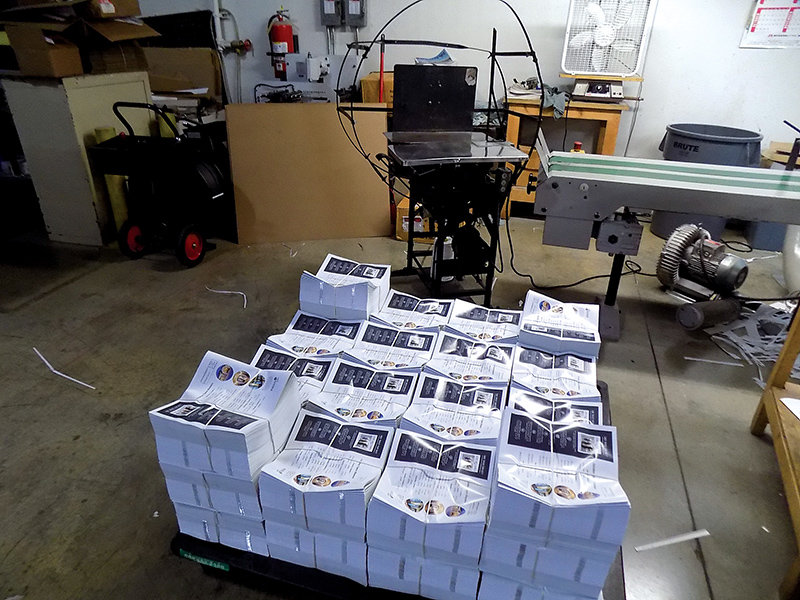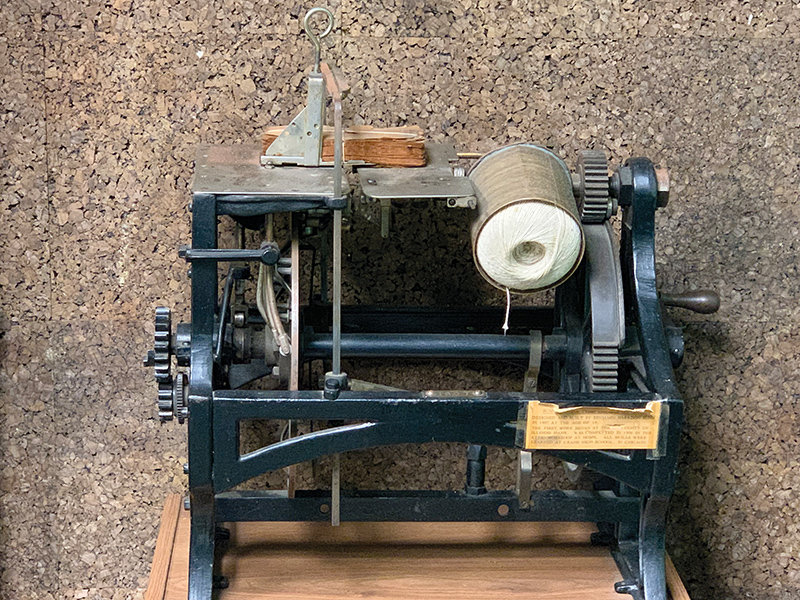 Neatly tied and stacked bundles sit ready for shipment. Twine produces a tight tie without cutting into papers, thanks to the BUNN tying machine. (Photo by Jerry Simpkins)
Neatly tied and stacked bundles sit ready for shipment. Twine produces a tight tie without cutting into papers, thanks to the BUNN tying machine. (Photo by Jerry Simpkins)
Many of the tools we use in our business have seen dramatic improvements over the years. Our printing processes have incorporated auto presets, digital printing, digital output devices, computer to plate technology, automated registration, square halftone dots, round halftone dots, elliptical dot patterns, Photoshop, inkjet labeling—the list goes on. It seems every time we find some way to improve a process someone comes up with a new and better machine to do just that, improve the function of the machine and the way that equipment helps to streamline processes and improve efficiencies. Most of these new inventions have brought about improvements in our industry that have paid major dividends and moved newspapers and printing in general forward.
While all this innovation has been taking place, without a lot of fanfare, one company has made its way into majority of the newspapers across the country and we continue to reap the benefits of its “innovation” for more than 112 years.
In 1906, Benjamin Harrison Bunn decided to find a better way to tie bundles of the U.S. mail. A year later, he invented the world’s first automatic package tying machine, securing a U.S. patent by 1908. The design and functionality of this unit is the same concept used in mailrooms used across the country over a century later.
From that day in 1907, when Benjamin Bunn automated the process of tying mail, the B. H. BUNN tying machine has been a family owned company, now on its third generation. At the helm is John Bunn, whom I recently interviewed for this article. For John, it’s not just about making money, and it’s not just about getting his name out there; it’s about quality, family pride and building a machine that his grandfather invented more than a century ago.
To this day, John expresses his pride with one simple phrase, “I tell our customers and employees, ‘We come into this life with nothing, and we leave with only one thing, our integrity.”
What Makes BUNN Stand Out
Although we know them for what they have done for the newspaper industry, BUNN tying machines today are in a number of other industries. BUNN has built more than 1,500 variations from the standard unit to meet different customer applications.
When I spoke with John, he asked me an odd question during the interview: “Where was I raised?” Not quite sure what he was getting at, I told him “Upstate New York.” John was noticeably pleased and asked me when I went to the bakery in New York if they tied cake and cookie boxes with string.
“Let me guess, a BUNN tying machine?” I said.
I felt John’s sense of pride as I made the connection. It’s the same pride I see him putting into each machine that BUNN manufactures today.
In our industry, BUNN has become a staple for many small to medium sized newspapers. I can attest to the fact that many newspapers prefer the BUNN tying equipment over strappers because of its durability and simplicity. The cost to own one is reasonable, especially when compared to some of the high-end strappers, and they are extremely easy to repair if anything breaks.
I honestly can’t remember a single newspaper I’ve worked at that didn’t have a BUNN. While some are older than others, they all seem to be workhorses and their simplistic design makes them the go-to units when others fail.
In one of the conversations I had with John, he informed me that most parts for all vintage BUNN machines are still available. Even if they didn’t have the part, they had the ability to make it.
With a machine designed in 1907, I asked John how they competed with the new high-speed strapping equipment.
“How many companies actually use the machine to its full speed capacity?” John said. “They are paying for something they wouldn’t or seldom use at those speeds. Our history has shown us that the average bundle speed, per our customers, is around 25 to 30 per minute. The standard BUNN tying machines are rated at 42 cycles per minute. The BUNN tying machine will still tie faster than the operators can handle the product. Don’t get me wrong, there are some applications that do run faster, but that’s okay, there is always room for the others.”
In many of the small and medium sized mailrooms I’ve managed, BUNN continues to be the fallback unit when all others fail. When the high-tech $30,000 in-line strapper goes down mid-run and you replace it with another strapper that also goes down, it’s time to break out the BUNN tie machine. Its reliability and simplicity have truly made it not only a fallback unit, but have also made it a primary use unit at many small and midsize properties.
Over the years there have been changes in BUNN tying machines. In general, there have been minor improvements as the models grew based on bundling needs. One major change was in 1977 with the BT Series which included a V-Grove clutch pulley to reduce clutch slippage during the knotting process, repositioning of the tension device to the inside for better control, and a larger access door to provide more ease when threading.
Perhaps the most significant equipment advancement was in the manufacturing of the frame. In the 1980s, foreign metals were beginning to show up in the recycled metals as many products were being scrapped. The metal quality was much lower than American steel which was creating manufacturing issues in the cast iron components. John told his father, who was the owner at the time, that he wanted to build the frame out of tubular steel instead of cast iron, making it stronger and heavier than the previous units. That process took place more than 28 years ago, and BUNN has not replaced a single bearing due to wear since the production of the new frame began.
 The tying machine designed and built by Benjamin Harrison Bunn in 1907 at the age of 19. (Photo courtesy of John Bunn)
The tying machine designed and built by Benjamin Harrison Bunn in 1907 at the age of 19. (Photo courtesy of John Bunn)
Continuing a Legacy
I asked John why he thinks the newspaper industry still uses BUNN equipment.
“The quality of our machine, customer service, support and having parts in stock to keep the operation running,” he said. “When a customer calls into BUNN, we know our product and what the customer needs for their machine. They get straight answers on how to fix things. Our ability to diagnose over the telephone is most helpful to the customer. They can Skype us, send photos, videos, or I can even listen to the machine over the telephone and tell them what’s wrong. The BUNN tying machine makes a very distinct sound. If you listen closely, you can hear what’s malfunctioning.”
In today’s challenging market, price seems to be a deciding factor for many printers. The standard BUNN units start out at $5,500 and considering the longevity these units seem to have, that’s a small investment with a lot of return. BUNN also offers their Ring Tyer Inline Unit, starting under $30,000 (depending on options).
BUNN 10-ply twine is manufactured in America and made to specifications for BUNN tying machines. I also asked John for his view on string verses plastic strapping and if any of those differences came into play with their continued success.
“I had a longtime customer call and ask the difference between strap and twine for his application. He said corporate was looking into strapping verses twine costs,” John said. “Let’s compare. Quarter inch strap typically has 18,000 feet per coil while a single case of BUNN 8-ply twine has 103,860 average feet per case. It will take 5.77 coils to equal a single average case of BUNN twine in feet. Based on single quantity pricing, the case of BUNN twine had a lower cost by more than $175.”
As far as service for BUNN equipment, it’s available in the U.S. and Canada through local distributors and factory trained technicians. BUNN also offers an online secured subscription based video system for training in-house maintenance staff. About four years ago, they also created a virtual repairman for those companies who wanted to train their own staff.
Looking ahead to the next hundred years, John said, “Our goal is to continue building the highest quality American made tying machines that our customers have come to know and rely on. We will continue to produce new variations to meet our current and future customers’ need by seeking new materials or by adding new options as the need arises, and to assist with customer products without changing from our humble beginnings.”
To learn more about BUNN and their services, visit bunntyco.com.
We Asked John Bunn…
E&P: What’s the history behind the BUNN tying machines?
John: Benjamin Harrison Bunn was mechanical minded boy who liked to make things work. His father, Romanzo N. Bunn, was a postal clerk in Chicago bundling the mail by hand using coarse rope to tie the mail which would cut his hands. One day, Romanzo came home from work and told his son he needed a machine to tie mail. Having the mechanical mind, Benjamin began experimenting to build what his father dreamed of, not having to tie by hand. BUNN tying machines have been used in many industries around the world to tie bundles. Pick an industry and the BUNN tying machine has probably tied something. From food to bottles, textile to foam, wire to PVC tubing, produce to wood, you name it, we’ll tie it.
E&P: BUNN is a family-owned company. How important is that to you?
John: It’s very important. I am a third generation owner. It all started for me back around 1969 when I was 10. I was in shop one day after school, and Gramp said, “Come with me, we need to make something.” It was the Number Two Machine (built in 1909) just returned from a U.S. postal trade show in Washington D.C. A part was missing upon its return. During the next several hours we made the part from scratch, (no prints or hand drawings). We made everything from hand, then installed and tested our work by watching the machine tie bundles. During this time, he explained and demonstrated how his mechanical tying machine worked. Here was a man who was 82 fixing a machine that was 60 years old without a print. Gramp had invented a machine that would always work no matter how old the machine was. What an amazing experience to be involved with something personal yet something so rare in this day and age.
E&P: How did BUNN typing machines get into newspapers and become the go-to units for the newspaper industry?
John: After the patent was approved, Gramp began trying different ideas by showing the machine around to local printers and newspaper companies. From 1918 through the 1920s, Gramp evolved the machine and the local printers began to purchase his invention. I remember a story where the newspapers were bundled with metal wire. The major complaint was that the wire was unsafe as it would burst open when the bundles were thrown off the trains or trucks at the local depots. It would also cut the workers if not handled properly. Benjamin went to these companies with the new invention—twine strong enough to hold the heaviest of bundles. Everyone was ready to purchase a BUNN Tying Machine after his demonstration, and soon, the orders began rolling in from newspapers companies.
E&P: Are BUNN tying machines still manufactured?
John: We are proudly the only American made tying machine of our style. Originally started in Chicago, we moved to Lakeland, Fla. in 1984. We still do all the major manufacturing in-house controlling our quality in machining, welding, painting and assembly.
E&P: Are parts still available?
John: This is our story every day. A customer calls in and says they have an old machine. It turns out it’s only 50 years old. We call it a “young BUNN.” They laugh, and tell us how much they love the machine and use it daily. Weekly, we see machines still being used from the 1940s to new ones. We get excited when they are back in the 1920s. Funny, while I was answering this question, I received a call from a customer from New York City who has two machines, one built in 1953 and one in 1955. What a testament to my grandfather’s invention.
 Jerry Simpkins has more than 30 years of experience in printing and operations in the newspaper industry. Contact him on LinkedIn.com or at simpkins@tds.net.
Jerry Simpkins has more than 30 years of experience in printing and operations in the newspaper industry. Contact him on LinkedIn.com or at simpkins@tds.net.
Comments
No comments on this item Please log in to comment by clicking here